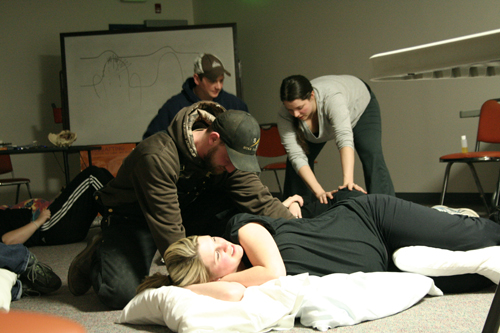
Brooke Chartier, 23, is pregnant with her first child. She and her husband, Tim Chartier, attend a series of five weekly childbirth classes at Sitka Community Hosptial. This class explores natural birth techniques, like massage, to lessen discomfort leading up to and during the birth process. (Photo by Anne Brice/KCAW)
Sitka Community Hospital — like most hospitals — delivers babies. But that hasn’t always been the case. For about two years, from 2009 to 2011, a lack of properly qualified physicians caused a shutdown of its obstetrics program. In the first part of a two-part series, KCAW looks at how the return of obstetrics has made a difference for expectant moms.
I’m at a birth class at Sitka Community Hospital. It’s a five-session series, and this week, first time moms are learning about natural childbirth techniques. A small group of women are lying on their sides with pillows wedged between their knees, with the dads sitting close by.
Brooke Chartier is due in just a few weeks. She’s 23 years old and comes from a family of five kids.
“I had always said I wanted to have five and I got on the pilot so I could fit all my kids in there,” said Chartier, “but being at the end of this pregnancy, I’m like, I’m just gonna see how one goes and then we’ll see.”
She says since this is her first pregnancy, she had no idea what to expect. “People always say that pregnancy isn’t like you see it in the movies,” she said. “Then going through it, it’s like, oh yeah, you know, I don’t look like my same self with just a belly. Like, everything changes. Not just your belly. And even though I thought I knew what it was going to be like, you don’t really know until you’re in it, I guess.”
Dr. Debra Pohlman provides Chartier’s obstetrics care. She worked at Sitka Community Hospital in the early 90s, and just recently came back to work as a family doctor delivering babies in 2011. She says caring for pregnant women is a privilege, and brings her a lot of joy.
“Most of medicine is dealing with people who are in pain, they don’t feel well, something’s gone wrong,” said Pohlman. “Obstetrics is a natural process that thankfully only a small percentage ends up being problematic, and the rest is a natural process where families invite you to be part of this miraculous thing called birth and it’s very invigorating.”
“They’re super good at Sitka Community,” said Chartier, “because they say if you feel nervous at all, call us, we’d rather have you come in a thousand times, 100 times with nothing wrong than not call us and have something really be wrong, so they don’t make you feel silly for calling.”
Sitka Community Hospital hasn’t always had a strong obstetrics program. In fact, starting in 2009, the OB program ended altogether because there were no longer any physicians who could perform cesarean sections (one left the hospital and the remaining doctor didn’t want to be on-call for c-section surgery around the clock).
Without an OB program at Sitka Community, pregnant women either went to SEARHC or had to leave town for medical appointments and to give birth, putting total trust into doctors with whom they had no relationship. There were a few midwives who did home deliveries at the time, but they weren’t trained in giving emergency c-sections.
When CEO Hugh Hallgren arrived at the hospital, it still didn’t have OB services. So, right away, at the suggestion of the board, he set out to rebuild the program. “You get the physician first, and we needed the physician to guide us in the process,” said Hallgren. “Physicians are not all the same. They have their strengths and they have their preferences.”
Word of Sitka Community’s struggles even reached Debra Pohlman in Anchorage, where she was teaching medical students and residents. “It kind of weighed heavily when I kept getting called and people were saying, ‘Our OB program is closed and we’d really like to reopen it.’ I wasn’t seeing anybody following in my past footsteps, so I thought, might as well do it.”
So, in September 2011, she moved back.
“When she finally said, yes, I’ll come back, it was like a gun going off to start a race,” said Hallgren.
Now, there are two full-time family physicians at Sitka Community Hospital, Dr. Pohlman and Dr. Charles Roesel, who deliver babies and perform c-sections. There is also a general surgeon who can provide c-sections and an OB/GYN who makes monthly visits to look at more complicated obstetrical cases.
Pohlman sees roughly 6 to 12 patients a day. She says that even though rural physicians work longer hours and get paid less, the relationships she has with patients and the high quality of life she leads, makes it more than worth it.
“I don’t want to be seeing 40 to 50 patients a day,’ she said. “Running them through. Literally talking to them for 5 minutes so that I can get a big salary and then when I get my time off, I can do all those things. Where here in Sitka, you can go fishing in the summer if you get up early and you’re not on call, before you come to work.”
The attention makes a difference for these soon-to-be moms.
In part two of this series, we’ll look at the challenges that rural hospitals face in keeping physicians, and learn more about Debra Pohlman’s reasons for returning to Sitka Community Hospital after an absence of nearly two decades.






























